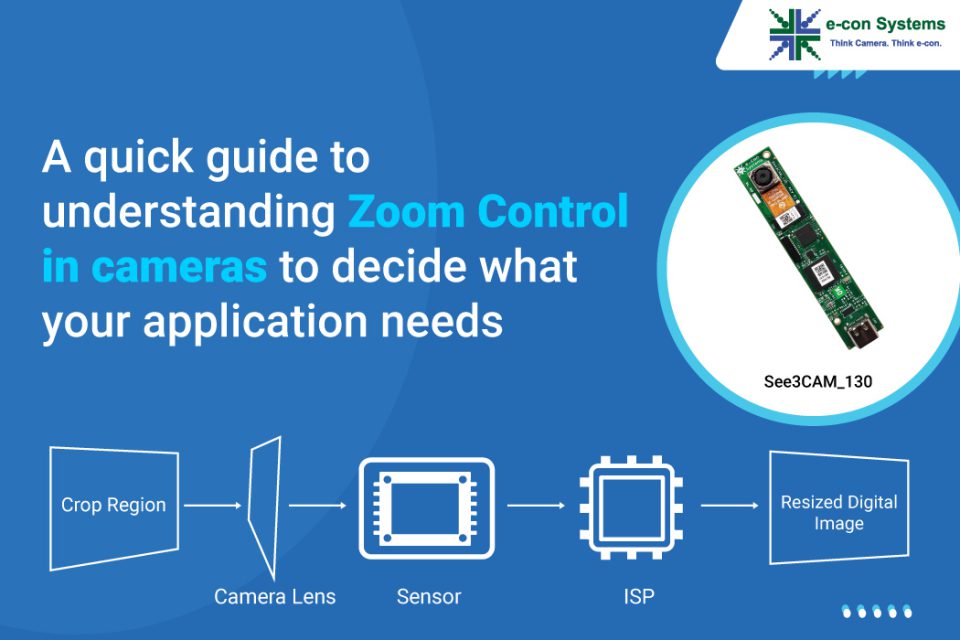As you may already know, in photography, “zooming in” refers to increasing the size of the subject or object without changing the position of the camera. Conversely, “zooming out” makes the object smaller. Regarding how these impact the FOV (Field Of View), the FOV decreases as the camera zooms in. Similarly, when zoomed out – the FOV increases.
In this article, we’ll look at the different types of zoom – and how they work. We’ll also share insights on how the cameras developed by e-con Systems come with state-of-the-art digital zoom features.
Why do cameras need the zoom feature?
Over the years, the zoom capabilities of cameras have grown leaps and bounds. They have become more versatile to help embedded vision applications frame the right shot as quickly as possible without manually moving away (or closer towards) the subject.
Today, there are more use cases than ever before that require the application’s camera to be equipped with the zoom feature to enlarge and extract a clear image. Hence, this feature plays an important role in powering modern embedded vision devices, such as document readers, low-vision viewers, digital microscopes, and more.
What are the different types of Zoom?
There are two types of zoom capabilities, namely Digital Zoom and Optical Zoom. Let’s go deep, see how they work, and find out which one may best suit your embedded vision application – based on your unique requirements.
Optical Zoom
In the case of optical zoom, the glass elements inside the lens move to increase or decrease the focal length of the lens. Optical zoom was used when there was a requirement to zoom in while retaining the highest possible image quality. Despite recent advancements in zooming technology, it remains the case even today.
The optical zoom feature is also generally preferred by higher magnification applications that use lower resolution image sensors. It ensures that the image quality doesn’t get reduced.
Digital Zoom
Digital zoom is implemented by leveraging the ISP or the software instead of using lens optics. To implement this, the source frame from the camera is enlarged by cropping a specific region and resizing it to the desired resolution. During this process, the image quality will be decreased due to the fact that the image is enlarged more than the actual resolution.
In a nutshell, zoom can be described as: Cropping resolution = Source resolution/zoom factor – resized to the final resolution.
For example, let’s consider a required final resolution of 1920×1080 – with the digital zoom set to 2X zoom. In such a case, the sensor will crop 960×540 resolution as the ISP enlarges this resolution into 1920×1080.
How does digital zoom work?
As earlier discussed, digital zoom can be implemented by using hardware or software. In hardware-based zoom, the Image Signal Processor (ISP) handles the zooming capability. First, the image resolution is cropped from the sensor after which the ISP resizes it. With regards to software-based zoom, the cropping and resizing are both executed in the software.
When an image is zoomed, there will be a significant loss in the quality of the image around the edges, as well as a distinct loss of sharpness due to the pixelated image caused by the resizing. The quality of the image can be recovered to a certain extent by enhancing the edges or sharpness through the ISP.

Fig 1: Zoom implementation
USB cameras with digital zoom capabilities designed by e-con Systems
e-con Systems has designed and developed custom color USB cameras that come equipped with digital zoom capabilities. Hence, there is absolutely no need for you to use a special optical lens to handle the zooming function.
Our cutting-edge cameras like the See3CAM_130 – 4K autofocus USB camera – can even support up to 8X zoom through its inbuilt ISP – offering a maximum resolution of 4208×3120 (13MP). For a resolution of 1920×1080, its sensor will try to maintain the aspect ratio and provide a resolution of 4208×2367 to the ISP. The resolution has a 16:9 aspect ratio – the same as that of 1920×1080.
See3CAM_130’s zoom control equips you to zoom in on this resolution and resize back to the 1920×1080 resolution. This zoom control is enabled from 100 to 800 – mapped to 1x to 8x values – with each step size denoting a 0.01x zoom.
The sensor binning will be disabled while increasing the zoom values for higher resolutions to maintain the same FOV. For resolutions such as 4K (3840×2160), See3CAM_130 will provide lower zoom control up to 2x only in order to maintain the aspect ratio and FOV.
As far as zooming is concerned, cropping happens in the center of the sensor while the “pan” and “tilt” controls are used to crop the specific region of interest on the entire sensor. These controls can be used to move along the entire FOV and the full resolution.
We hope this article helped you understand the nuances of optical and digital zooming – helping you decide which one would suit your product requirements. If you are looking for any help in integrating cameras with digital zoom capabilities into your applications, please write to us at camerasolutions@e-consystems.com. You could also visit the Camera Selector to have a look at our complete portfolio of cameras.

Prabu is the Chief Technology Officer and Head of Camera Products at e-con Systems, and comes with a rich experience of more than 15 years in the embedded vision space. He brings to the table a deep knowledge in USB cameras, embedded vision cameras, vision algorithms and FPGAs. He has built 50+ camera solutions spanning various domains such as medical, industrial, agriculture, retail, biometrics, and more. He also comes with expertise in device driver development and BSP development. Currently, Prabu’s focus is to build smart camera solutions that power new age AI based applications.




